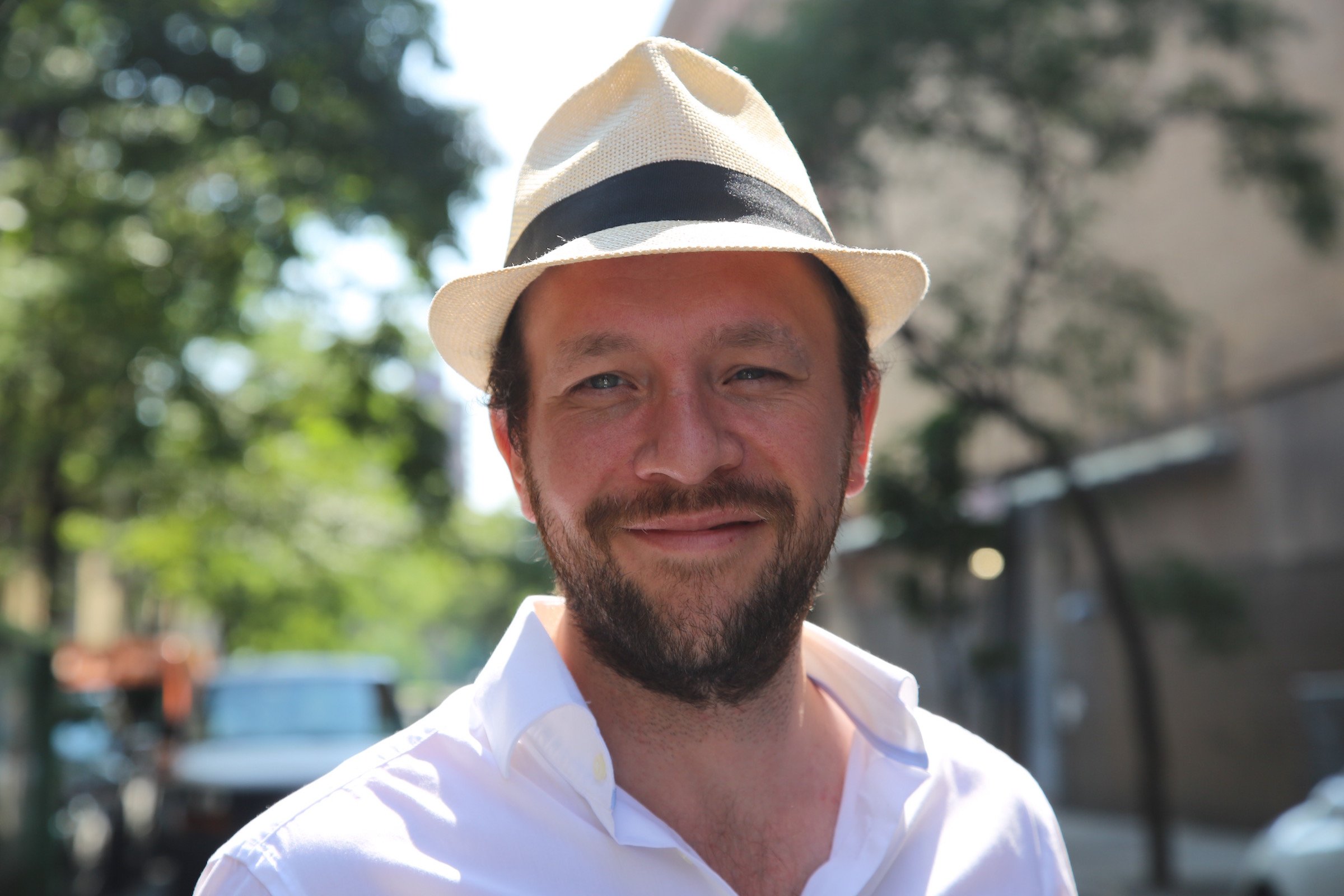I’ve lived in Nepal for more than two years now, and there hasn’t been a day when I haven’t thought of earthquakes. I knew I was moving to an earthquake zone that geologists warned was overdue for a massive quake, and I have a tendency to over-prepare, probably acquired in my 20-plus years on the road as a foreign correspondent. I didn’t have one set of earthquake-ready “go-bags”—the backpacks that hold essentials such as a change of clothes, a first aid kit, spare batteries and some basic food—but three sets, some bigger than others for winter gear and all in different locations around my house and garden.
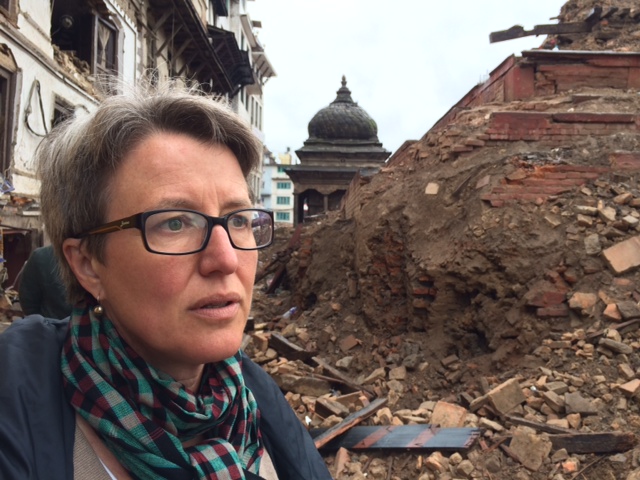 Yet, when a massive 7.8 magnitude earthquake hit central Nepal on April 25, 2015—a rolling wave that moved the Kathmandu valley 1.5 meters in five seconds and was followed by hundreds of big and small aftershocks that are still continuing today—I realized how little I really knew about the ground I lived on. In that earthquake and its aftershocks, more than 9,000 died, tens of thousands were injured and 3.5 million people were left homeless.
Yet, when a massive 7.8 magnitude earthquake hit central Nepal on April 25, 2015—a rolling wave that moved the Kathmandu valley 1.5 meters in five seconds and was followed by hundreds of big and small aftershocks that are still continuing today—I realized how little I really knew about the ground I lived on. In that earthquake and its aftershocks, more than 9,000 died, tens of thousands were injured and 3.5 million people were left homeless.
An earthquake is not a single occurrence. It remains a constant looming, unpredictable presence. Fear, hypervigilance and intrusive thoughts have become ubiquitous, always lurking in some corner of my mind. A counselor at my son’s school, speaking to parents weeks after the first earthquake, gave a critical piece of advice. “When your child tells you he is scared, don’t answer that ‘everything will be alright’. There is no way to guarantee that everything will be alright. Your child needs to be aware that the earthquake can come back, and these are the ways to better prepare.”
An ordinary day
On April 25th, my son Lucas and I were following our standard Saturday rituals while my husband John was out of town in the U.S. on business. We woke up early to take Biko, our Rhodesian Ridgeback, for a walk across the cultivated fields below our house. Lucas did his violin practice, and we then started to drive down into the nearby city of Patan, Kathmandu’s twin city, for an early pizza lunch. I noticed that something was not right as we descended a hill towards a bridge over the Nokhu river. At first, I thought I had a flat tire. Then I thought that I’d hit a nearby motorcyclist as I saw him fall off his bike and slide down the road. But then I realized it had to be more than that. I had trouble keeping the car on the road as it jerked up onto two wheels on one side and then slammed back down onto the pavement. Nearby, brick walls were collapsing, and trees were bending down towards the ground, and back up again, as if in a huge wind storm. Everywhere people were screaming. I pulled over, turned off the engine, pulled the handbrake and told Lucas: “It’s an earthquake. Put your head down.”
The rest of the day was run on adrenaline. We drove back home. Our house looked fine. Biko was very glad to see us. I told Lucas to stay outside, as I began doing fast runs in and out of the house to get food, blankets, my computer and camera, any other essentials. I knew to expect aftershocks, but I had no idea how powerful they can be or how much damage they can create.
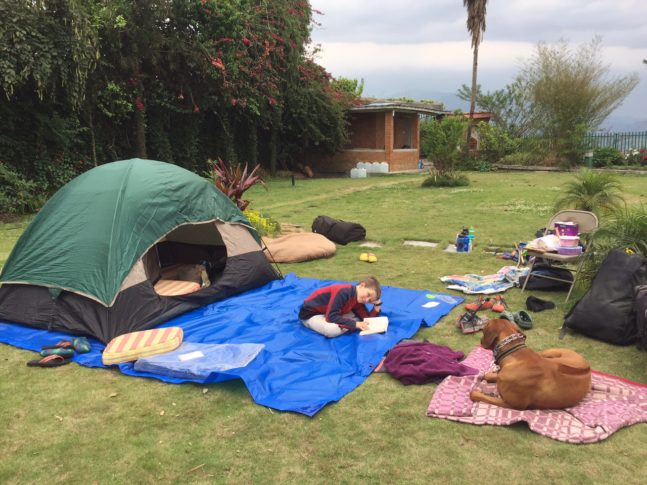 Some 30 minutes after the first earthquake, as I was squatting in front of a safe trying to open it and grab passports and emergency cash, I heard a loud crack, which was followed by a vertical jerking of the house that was so powerful that it threw me onto my back. In the yard, Lucas screamed for me, and I ran down the stairs. That’s when I decided to stay out of the house for a while. Emotionally exhausted, Lucas fell asleep on Biko’s blanket while I set up a tent in the garden, our refuge for two weeks.
Some 30 minutes after the first earthquake, as I was squatting in front of a safe trying to open it and grab passports and emergency cash, I heard a loud crack, which was followed by a vertical jerking of the house that was so powerful that it threw me onto my back. In the yard, Lucas screamed for me, and I ran down the stairs. That’s when I decided to stay out of the house for a while. Emotionally exhausted, Lucas fell asleep on Biko’s blanket while I set up a tent in the garden, our refuge for two weeks.
Near dusk, Lucas and I ventured out of our garden on foot downhill about 500 yards to Khokana, one of the valley’s oldest towns. It has been covered in a cloud of dust much of the day, but it wasn’t until we got to it that we could see the earthquake’s power. More than half the town’s traditional mud-brick buildings had crumbled. Entire brick walls had been ripped off. A massive three-story, pagoda-like Indrayani temple in the central square was precariously leaning, jagged cracks on its walls. Miraculously, because it had happened midday and most people were out of their houses, only 14 people had died.
Pre- and post-quake
Pre-quake, I was often asked whether I liked living in Nepal. I love Nepal. Despite the massive pollution, the daily winter electricity cuts, the legendary traffic jams and ubiquitous garbage, Nepal won me over with its natural beauty, its living religions, and also the warmth and quirkiness of its fun-loving people. As so many Nepalis have told me: “We survive and exist not because of our government but in spite of it.”
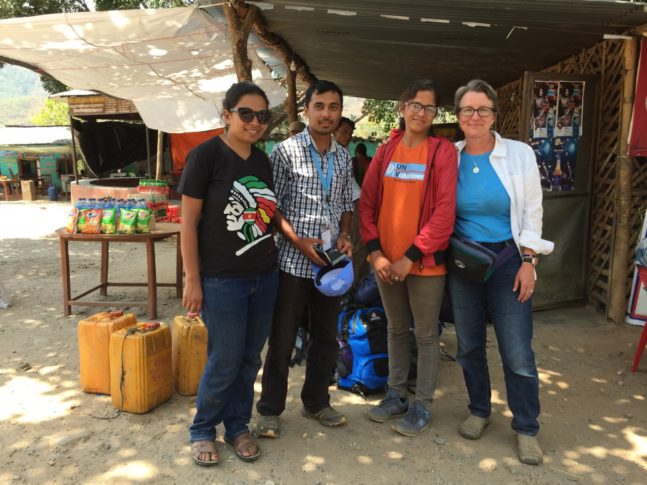 I owe much to my Nepali friends, colleagues and neighbors who immediately reached out to make sure we were okay. Keshav, our cook, a former Marxist-Leninist revolutionary who also doubles as my translator and fixer on reporting stories, left his own badly damaged house and came to our place that first evening, building an impromptu tarp shelter for our earthquake gear where he and Biko slept. Lucas and I joined him on his motorcycle as I reported on the destruction in the valley. With our internet down, we found connectivity and much appreciated company at the home of my friends Kunda and his wife Milan, where we weathered a few big aftershocks sitting together in their garden. Another impromptu family were my husband’s World Bank colleagues, several of whom came to the office within the first hours to track down all staff.
I owe much to my Nepali friends, colleagues and neighbors who immediately reached out to make sure we were okay. Keshav, our cook, a former Marxist-Leninist revolutionary who also doubles as my translator and fixer on reporting stories, left his own badly damaged house and came to our place that first evening, building an impromptu tarp shelter for our earthquake gear where he and Biko slept. Lucas and I joined him on his motorcycle as I reported on the destruction in the valley. With our internet down, we found connectivity and much appreciated company at the home of my friends Kunda and his wife Milan, where we weathered a few big aftershocks sitting together in their garden. Another impromptu family were my husband’s World Bank colleagues, several of whom came to the office within the first hours to track down all staff.
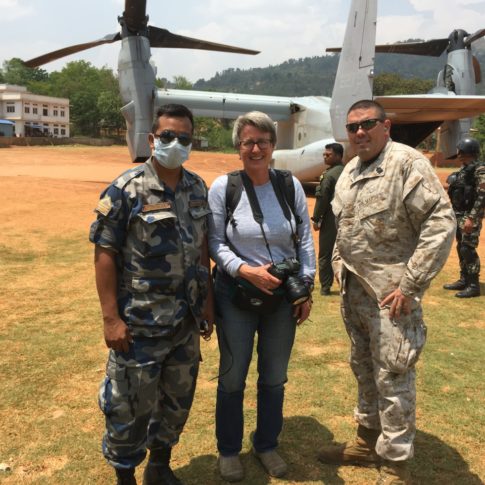 For the first time, I was living the story that I was reporting. The quake had in one way or another affected everyone in 14 of Nepal’s 75 districts. It’s the language we all had in common. In Kathmandu, people greeted each other for weeks by asking: “Where were you when the quake hit?” After large aftershocks, they still start conversations with “Did you feel that?” After a powerful 5:00 a.m. aftershock one morning, a friend tweeted: “Wakey, Wakey. That was a big one.” We were all part of a big community. We all suffered from earthquake “hangovers”, the feeling that the earth was moving even when it was not. That first week after the 7.8 magnitude quake, I’ve never hugged and been hugged by so many people, even just acquaintances.
For the first time, I was living the story that I was reporting. The quake had in one way or another affected everyone in 14 of Nepal’s 75 districts. It’s the language we all had in common. In Kathmandu, people greeted each other for weeks by asking: “Where were you when the quake hit?” After large aftershocks, they still start conversations with “Did you feel that?” After a powerful 5:00 a.m. aftershock one morning, a friend tweeted: “Wakey, Wakey. That was a big one.” We were all part of a big community. We all suffered from earthquake “hangovers”, the feeling that the earth was moving even when it was not. That first week after the 7.8 magnitude quake, I’ve never hugged and been hugged by so many people, even just acquaintances.
View from the States
Back in the States for vacation this summer, many friends asked me why I didn’t leave immediately after April 25th. Many foreigners did leave. Kathmandu experienced an exodus. Some embassies evacuated families and non-essential personnel, including DFID, the arm of the U.K. government that oversees international aid. Over 300,000 migrant workers from India and other areas of Nepal left Kathmandu within days.
Yes, I could have left. I certainly worried about Lucas and his safety. But my husband John was back in Nepal working, saying that this was the time help was most needed in Nepal, so it was absolutely the wrong time for us to leave. In addition, I was reporting. The World Bank gave all its employees and their dependents an opportunity to evacuate, but in the end only one of about 400 people chose to do so. Lucas said he did not want to leave as long as both his parents were in Nepal. John and I felt that if we left the place we call home, we were telling our son that when the going got tough, the easiest solution was to leave the problem behind.
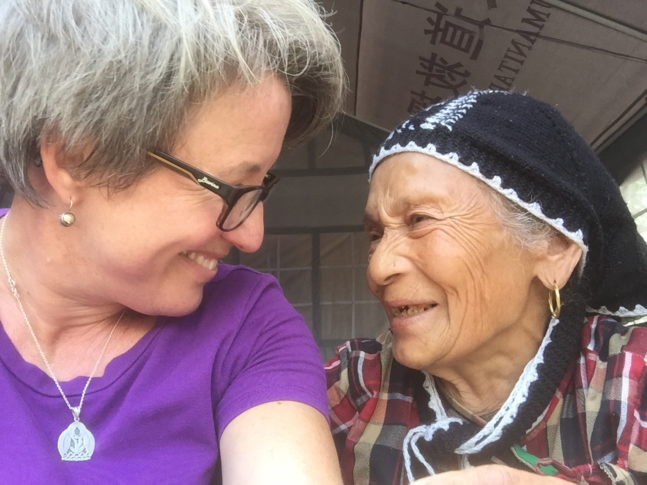 I knew even in the first minutes after the first earthquake that I couldn’t possibly leave. Nepal is my home. I have tried to demonstrate solidarity with the country and my friends there in the only way I know how: by writing.
I knew even in the first minutes after the first earthquake that I couldn’t possibly leave. Nepal is my home. I have tried to demonstrate solidarity with the country and my friends there in the only way I know how: by writing.
About the Author :
Marc Rognon joined the Lycée in October 2016 as Digital Communications Manager. He brings to the Lycée his experience as a TV journalist, media consultant and project manager. After almost 10 years as a producer and senior editor at France24, the international news channel, he spent one year in Iraq to create the country’s first news channel and worked extensively in North and West Africa to train journalists on reporting and news gathering. He is passionate about travelling, discovering and understanding new cultures and languages.


